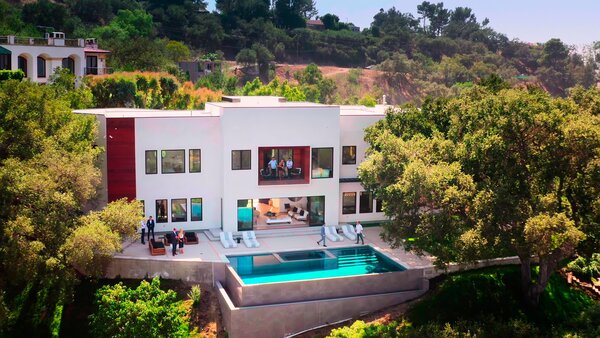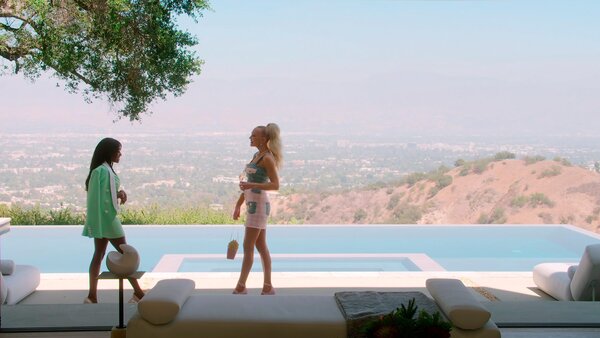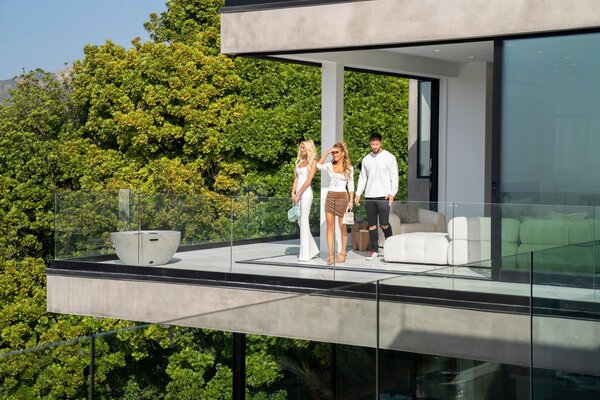Surely, there’s nothing sinister behind all those sliding glass doors…right?
I saw the best minds of my generation enthralled by drone shots of glass walls in the biggest houses I’d ever seen sliding open to infinity pools that fell into the canyons above Los Angeles.
That’s the power of Selling Sunset, the hit reality show on Netflix in which Los Angeles real estate agents at the Oppenheim Group sell homes and get in fights about who is mean and who is nice while wearing impractical outfits and saying things like "Luxury, glamor, style is my thing." It’s a mostly white, patriarchal wonderland overseen by the muscled Oppenheim brothers, a world where wealth is triumphal and success comes in the form of sales, a kind of Southern California Gordon Gekko fantasy set to a pounding pop soundtrack.
It’s not the sort of setting I’d seek out otherwise, for a variety of reasons, but something about watching those giant glass walls releases some pleasure that I can’t refuse. For a not insignificant portion of the past three thrilling years of life, I was curled up on my couch watching this show, and I wasn’t the only one. Plenty of people I admire for their critical thinking skills sat enrapt by a program run by the primal urges of heterosexuality and capitalism. One season culminated in an episode where an agent—on her wedding day—sold the house where she was getting married. Her friends’ general reaction was "That’s awesome," a slam dunk for the Protestant work ethic. I would probably feel my soul leave my body if I endured that day in real life, but seeing it on screen, I was transfixed and maybe even teared up. What the fuck.
What’s happening here? Yes, I’m a lifelong fan of reality TV—for better or worse, Paris and Nicole raised me with The Simple Life—but more than once I’ve caught a reflection of myself on my screen after another episode of Selling Sunset fades to black and I’ve wondered why watching this show is what I’m doing with my one wild and precious life. What’s the source of its power? It’s not ambient TV—it’s too gripping, weirdly enough, for a show that’s half an advertisement for homes most of us will never be able to afford. It’s not purely real estate porn, either, judging from the characters’ popularity among the chattering Twitter classes. If it’s escapism, it’s an odd form of it; a lot of the show is acted office work and company politicking, which I get enough of in real life. And we only get to see people living in these homes when one of the realtors consummates her rags-to-riches story line by moving into one. Lifestyles of the Rich and Famous this is not. It’s not even Cribs. It’s hard to identify exactly what it is.

A house on the fifth season of the Netflix show ‘Selling Sunset.’
Courtesy of Netflix
"Reality is just an illusion," Christine Quinn, Selling Sunset’s villain and breakout star and Cassandra of our times, said on the Call Her Daddy podcast, one of her many media appearances since the show propelled her to stardom. Fans have eaten up the realtor turned Balenciaga model’s sassy confidence and the way she can evade her castmates’ earnest outrage over her supposed transgressions by twisting the truth and rolling her eyes at the lame finger-waving of the morality police around her.
See this exchange where one agent, Mary Fitzgerald, the virtuous new wife mentioned above, confronts Quinn about something uncouth the latter said:
Christine: It was a joke.
Mary: If that was a joke, then stop joking, because your jokes aren’t funny.
Christine: My jokes are hilarious.
Mary: No, they’re not.
Christine: Yes, they are.
Mary: Then why does everyone have a problem with you?
Christine: Because they have no sense of humor! What can I say?
Mary: Or you’re acting like a bitch.
Christine: Okay, maybe I am.
Like the show itself, Quinn’s impossible to pin down. (In interviews outside the show, she claims that the show’s editors distort her to make her look worse.) She delights when one castmate calls her look a combination of Elizabeth Holmes and Ivanka Trump, and, well, of course she does. The slickly disorienting, opulent show upholding conservative consumerist values was the perfect product of the Trump years. And like the wave of right-wing populism that washed over the country in 2016, Selling Sunset’s aesthetics have been brewing for some time.
Producer Adam DiVello pioneered a new style in the aughts with Laguna Beach and The Hills, which featured a still camera, cinematic look and feel that was a world away from the gonzo documentary style of Survivor and other Y2K reality juggernauts. And DiVello’s influence grows. Even the doyens of reality fare, the Kardashians, have adopted some of DiVello’s glossy stillness for their new Hulu show. DiVello made life on reality TV look seductive and aspirational, partly by taking some of the messy "reality" out of it; The Hills’ finale ended with a teary goodbye between the protagonist and her on-again-off-again boyfriend, caught on a crane shot that pulled back to reveal a stage lot, fake Hollywood sign background, and a crowd of producers choreographing the scene.
In worlds like these, it’s hard to know what to hold on to, particularly when they’re slippery sliding doors. Homes have been central to reality TV since the first roommates moved into the first Real World house in 1992. Since then there have been Big Brother mansions, Love Island villas, and Bachelor manors. Even docu-style shows like the Real Housewives focus on domestic real estate even as they track their stars in the wider world (hello, Bluestone Manor). On Selling Sunset, the houses are the constant, the medium in which all else exists, the stage for the fights and speeches, the slurred insults, the storming exits. They’re more than backdrops; they’re the reasons for the seasons, the goods that must be bought and sold to keep this economy running, what gives this universe its form. And the spell cast by these shows can only be understood by piecing together the puzzle of the homes they present.
—
If you’ve seen the show, the typical Selling Sunset home springs to mind without explanation. There’s some variety, but the canonical ones mimic each other as though they all grew from the same root buried in the Hollywood Hills. If you haven’t had the pleasure, picture a house that’s big, modern, and white. The homes feature an aesthetic so polished and consistent that they sometimes have an uncanny valley effect, as though someone typed "modernist building" into an AI image generator and built the results. The slick aesthetic melds beautifully with DiVello’s cinematic approach. White walls neatly frame confrontations; views of Los Angeles fading into the distance make the perfect backdrops for staged dramas.
The house at 8408 Hillside Avenue, featured heavily in Season 1, when it was under construction, and whose completion was revealed at the start of Season 2, is the exemplar. It’s a five-bedroom, 20,000-square-foot stunner on a promontory overlooking the Sunset Strip that sold for $35.5 million.
Jason Oppenheim, president and founder of the Oppenheim Group, seems to nod in recognition when I ask him about it. "Hard to beat that house, because it is the highest quality and best designed and curated house arguably in all of the Hollywood Hills," he tells me, one of several conversations I had with those involved in the real estate on the show, in an attempt to understand the appeal of this home and others that look garish to me but clearly attract many deep-pocketed buyers.
The Hillside house’s details are so minimal that the building looks like a digital rendering. Ceilings are high and interiors are cavernous. Walls are white, stairs float, guard rails are thin slabs of cantilevered glass, and, of course, glass walls slide back before an infinity pool melts into the horizon.
The house sets the tone for others that follow. Jason and others confirmed to me that what you see on the show reflects what’s popular in the area. On the show, an agent, Chelsea Lazkani, calls the aesthetic a "sexy MoMA" look, and she’s not wrong. There’s something cold and self-important—magisterial—about the vibe, a sort of chilly American imperial feel. It was designed by South African architecture firm SAOTA, creators of superluxe homes around the world. Mark Bullivant, a principal there, tells me that the aesthetic has roots in the Hills; the area’s midcentury-modern Case Study homes partially inspired 8408 Hillside.
"Hillside is kind of one canyon across from the Stahl House [Case Study House No. 22, designed by Pierre Koenig], which is obviously an iconic structure," Bullivant says. "Taking a stroll along Sunset Boulevard and seeing how that Stahl House roof just hovers over you—that certainly had quite a big impact in the way that we have thought about these hillside homes."
The midcentury aesthetic comes up regularly on the show, as it does in real life. Richard Neutra and Harry Gesner projects make appearances. (Gesner is one of Jason’s favorite architects, he tells me.) At first blush, the comparison to midcentury modernism seems like a stretch. Midcentury modernism has been glamorized by publications like this one as the style of choice for sensitive aesthetes. It’s warm and down-to-earth, not loftily floating above like these aloof manses. But over the past decade or so, a handful of academics have published books complicating this take on the style. In Little White Houses: How the Postwar Home Constructed Race in America, University of Washington history professor Dianne Harris describes how American modernism in the 1950s was the style of elites. She writes that in 1949, Russell Lynes, an editor at Harper’s magazine, published his famous, tongue-in-cheek "brow chart," which divided forms of entertainment and decor not by class, as 19th century tastemakers might have done, but by "brow height." Low-brow tastes tended to beer and overstuffed chairs; upper-middle brow to Empire furniture and dry martinis. A simple red wine and furniture by the Eameses and Kurt Versen were for those in the know at the top.
Harris also describes how Elizabeth Gordon, editor of House Beautiful, one of the premier home design magazines of the postwar period, espoused the style we now call midcentury modernism as a gentler alternative to the often harsher styles of prewar Europe. She had more than an aesthetic agenda. Gordon suggested International Style modernism "would lead to the demise of American democracy," Harris writes. "Gordon ultimately became a renowned Cold War propagandist, and, like some others of her time, she viewed house form and design as crucial tools in the effort to establish the cultural supremacy of capitalism, democracy, and American national identity."
The America that Gordon celebrated was, to put it lightly, a mixed bag. It was a triumphant nation emerging victorious from two world wars to a historically unprecedented economic boom, but it was also deeply racist and still legally segregated. Those years were sort of the country’s halcyon days for white supremacy, and these midcentury modern homes were by and large only available to white people.
Kristina Wilson, professor of art history at Clark University and author of Mid-Century Modernism and the American Body: Race, Gender, and the Politics of Power in Design, thinks nostalgia for the modernist architecture of the ’50s is not easily separated from that political past. "The appeal of midcentury modernism over the last 30 years strikes me as very similar to the appeal of the Colonial Revival of 100 years earlier," she tells me. "In the late 19th century and throughout the first several decades of the 20th century, the most popular interior decorating style was some form of ‘American Colonial.’ This was marketed with references to an extremely white historical narrative of the greatness of the country’s founding. It was also marketed as a style of simplicity and honesty after the excesses of Victorian interiors. Midcentury modernism’s arrival as a phenomenon in the late 20th century comes in the wake of a few decades of decorative excess in the 1970s and 1980s and is presented as simple, honest, and with historical references to a noble historical past.
"In short, midcentury modernism is today’s colonial revival."
—
Unsettling—but the parallels to the Selling Sunset style are becoming more apparent. The show is something of a white supremacist fever dream, where idealized white bodies pursue marriage, reproduction, and the accumulation of wealth. The main cast in the first season is all white; there are some nonwhite buyers and agents as the show goes on, but whiteness is the inescapable norm. Being Mexican American and having spent two years living in L.A. rolling my eyes at Anglos telling me where to get the best tacos in the city, I’m a little sheepish at my betrayal to myself. Sorry to the ancestors: I’ve been lining colonizer pockets while curling up on my couch and calling it self-care.
Maybe, I tell myself, eager to salvage some self-respect, there’s hope for these homes. After all, they’re not midcentury-modern revival—they’re sleeker, bigger, brighter. It’s tempting to think that the Selling Sunset homes might’ve shed some social baggage like they ditched the wall-to-wall carpeting and avocado appliances. But, sadly, though their details might’ve changed, these houses resurrect the ’50s playbook in their relationship to their city.
The postwar period was a time of white flight from cities into suburban areas, when the perception of danger downtown drove white families to suburban areas, like the Hollywood Hills. When I talk to a developer whose property was featured in the second season, I hear a refrain that sounds straight out of the Eisenhower era. "L.A. is just a mess," he says. "It’s heartbreaking to see what’s happening. Politics in general, the homeless, the crime…it’s horrific.… L.A. in general is just kinda breaking down."
Jason reiterates the sentiment: "I think privacy and security for me personally are unbelievably important and have become far more important over the last few years as L.A. has had more problems with homelessness and crime."
Never mind that the realities of crime today are often far from what’s described in politically motivated screaming headlines. People head to the Hills to get away from the scary threats of city living, and the Selling Sunset homes reflect that. When the realtors on the show talk about these properties, none of them are desirable because they’re in areas buzzing with life and walkable neighborhoods. These homes shun the street. One listing in the fifth season in Pacific Palisades is anomalous for being close to a public space, Potrero Park, though the green space is only apparently valuable for the views it allows of the Pacific as it cuts through neighboring development. These houses are as disconnected as possible. Antisocial.
Their only connection to the wider world is via views of the city. Those views aren’t a physical part of the homes, but they might as well be: They’re a defining part of the Selling Sunset style, and they, too, have roots in midcentury modernism—think of Julius Shulman’s iconic photo of the aforementioned Stahl House, with two white women lounging over the city. The views are scenic and beautiful, sure, but they’re more than that.

Realtors Chelsea Lazkani and Christine Quinn chatting in front of one of the many views on ‘Selling Sunset.’
Courtesy of Netflix
"Views are all about power," Wilson tells me, "power of sight over others, the power of being removed and being able to look down and assert control through visual knowledge of the entire so-called playing board of the game of life."
Another homeowner I talked to who had a house featured on the show feels something similar. "My dream as a ‘young gay’ moving from the Midwest was to own a home in the Hollywood Hills," he tells me. "I had gone to so many parties of older gay guys, in spectacular homes with views of L.A. And it’s like, ‘Wow. This is my dream.’… You live in the Hollywood Hills with a view, you’ve made it."
"Every design decision for a house in the Hills is all to boost your ego, and that’s why it caters to the rich bachelors," Jhoiey Ramirez, a designer who worked on several homes on the show, tells me. "Their ego feeds their success, and their success feeds their ego. Their home needs to keep feeding both."
—
"The prime technique of power is now escape, slippage, elision and avoidance," wrote the Polish sociologist Zygmunt Bauman in the late 1990s. He described that era as one in which the old, ossified power structures of 19th century Europe had been melted down, but instead of having been replaced by the new, solid, idealist societies that radicals envisioned, society stayed melted, perpetually unstable. In this "liquid" world, the powerful no longer sat on thrones in castles, their names emblazoned across the land, but instead were constantly flying across borders, hidden behind layers of shell companies, always able to avoid answering the people they control. Because the pace of change is so fast and unpredictable, it’s nearly impossible for people to organize and agitate for better conditions for themselves, and so most people spend their lives in a whirlpool, just trying to keep their heads above the water. Bauman called the condition "liquid modernity."
The sociologist wrote about the architecture of the liquid modern world, but he focused on contemporary gathering places like airports and shopping malls. He didn’t write about homes in the Hollywood Hills, and he never got the chance to watch Selling Sunset. But the interiors of these homes sometimes feel more like airports or malls than like traditional houses, and Bauman was so adept at analyzing the relationship between power and culture in the weird internet age that his commentary feels strikingly relevant to the show.
"Powerful, ‘more real than reality’ images on ubiquitous screens set the standard for reality and its evaluation, as well as for the urge to make the ‘lived’ reality more palatable," he wrote in 1999. Bauman understood how the wealthy would steal themselves away to private hideaways where they wouldn’t be disturbed by their subjects. I think he also would’ve understood why these houses look the way they do. Though they follow the ’50s playbook in their relationship to L.A., the architecture of the Selling Sunset homes is a sort of Pokemon-evolved form of postwar design, adapted to the delirious, digital capitalist world of 21st-century America.
The homes’ interiors are slick and expansive. Gone are woods and natural textures that could snag the eye, replaced by expanses of glossy sheetrock. Details are minimized so one’s ego can float unfettered, and infinity pools provide the illusion that these spaces go on forever, that the entire universe is set dressing to your living room. It’s a frictionless aesthetic of boundless personal freedom, private isolation, and power over others.

Realtors Emma Herman and Chrishell Stause with developer Micah McDonald, checking out a view.
Courtesy of Netflix
See the full story on Dwell.com: The Selling Sunset Theory
Related stories:
- How Tile Took Villareal CF to the Top
- Millennials Are Coming for the Tiny Collectible Christmas Village
- What It’s Actually Like to Stay in One of Those Movie-Home Replicas on Airbnb
Read More
By: Jack Balderrama Morley
Title: The Selling Sunset Theory
Sourced From: www.dwell.com/article/selling-sunset-home-design-49968d83
Published Date: Mon, 19 Dec 2022 18:29:58 GMT
Did you miss our previous article...
https://trendinginbusiness.business/real-estate/fun-in-the-sunshine-state-7-outdoor-activities-in-jacksonville
.png)





